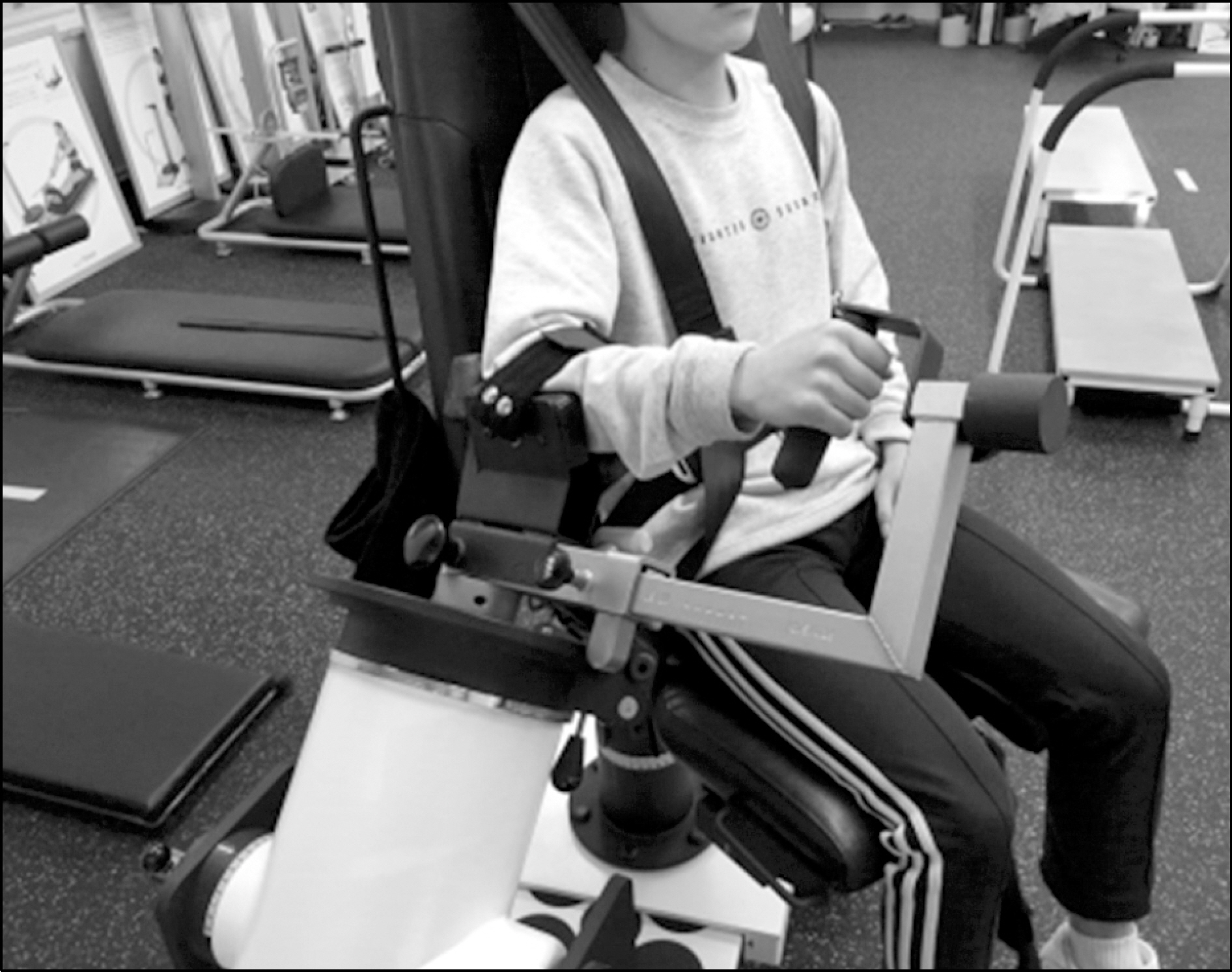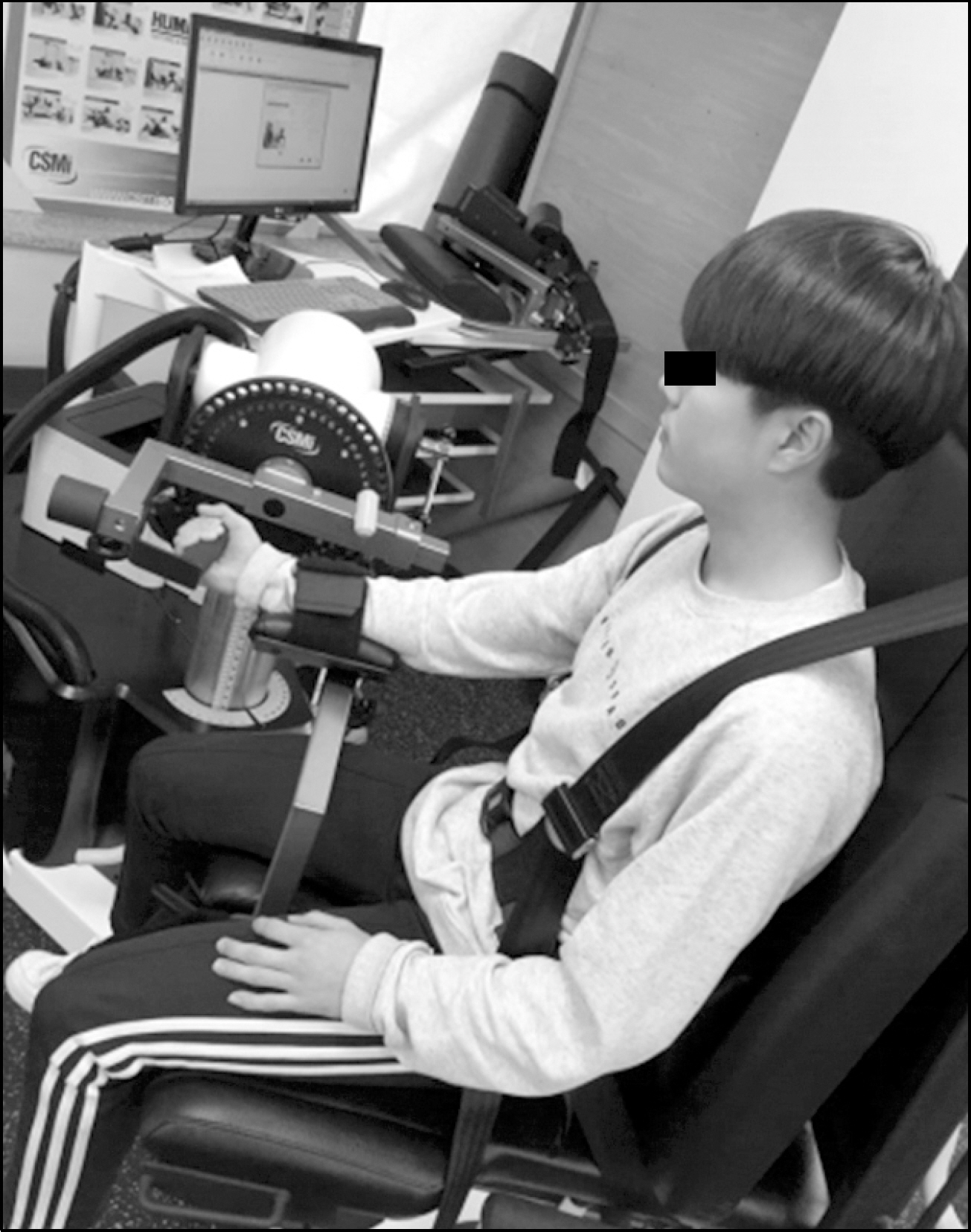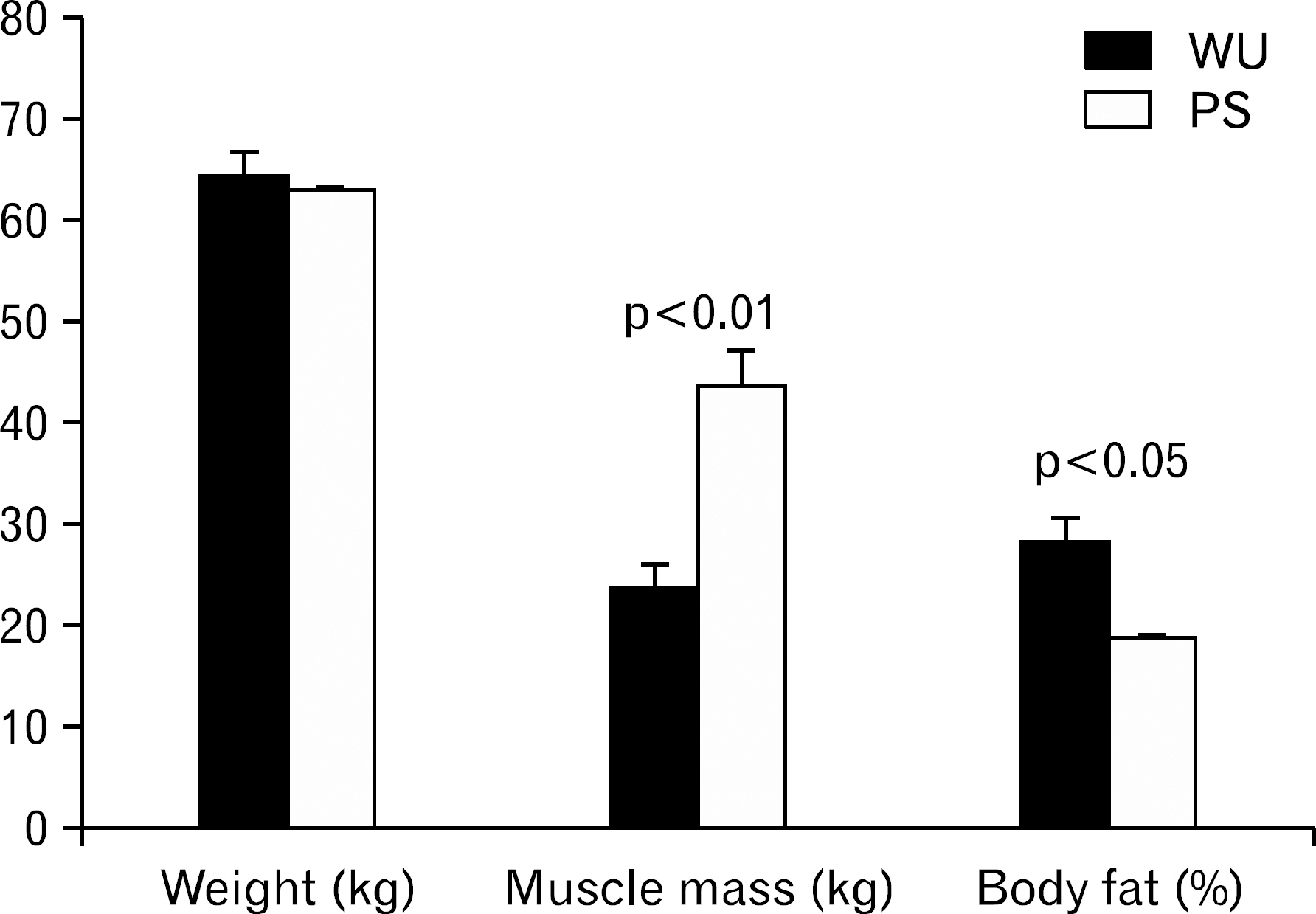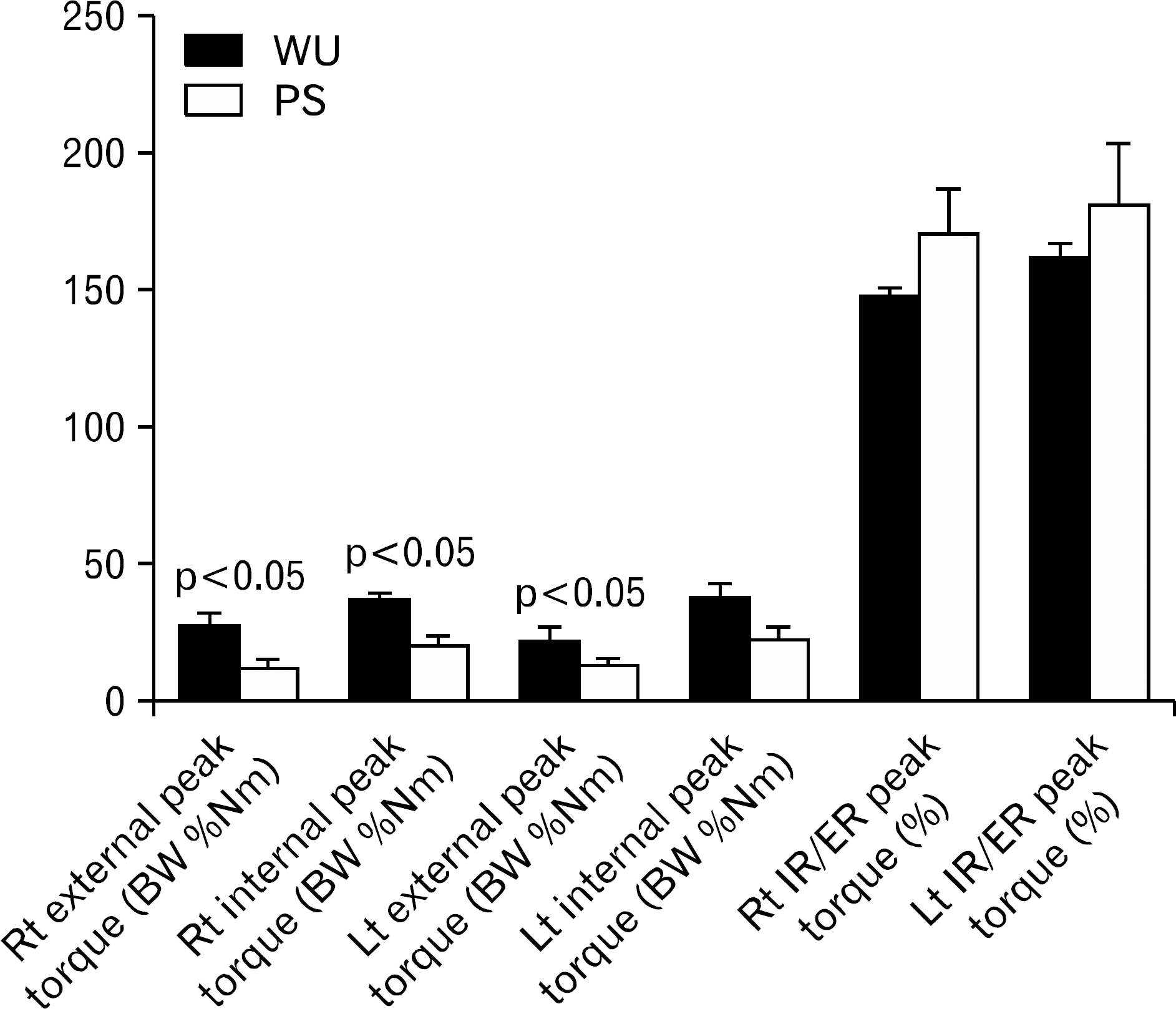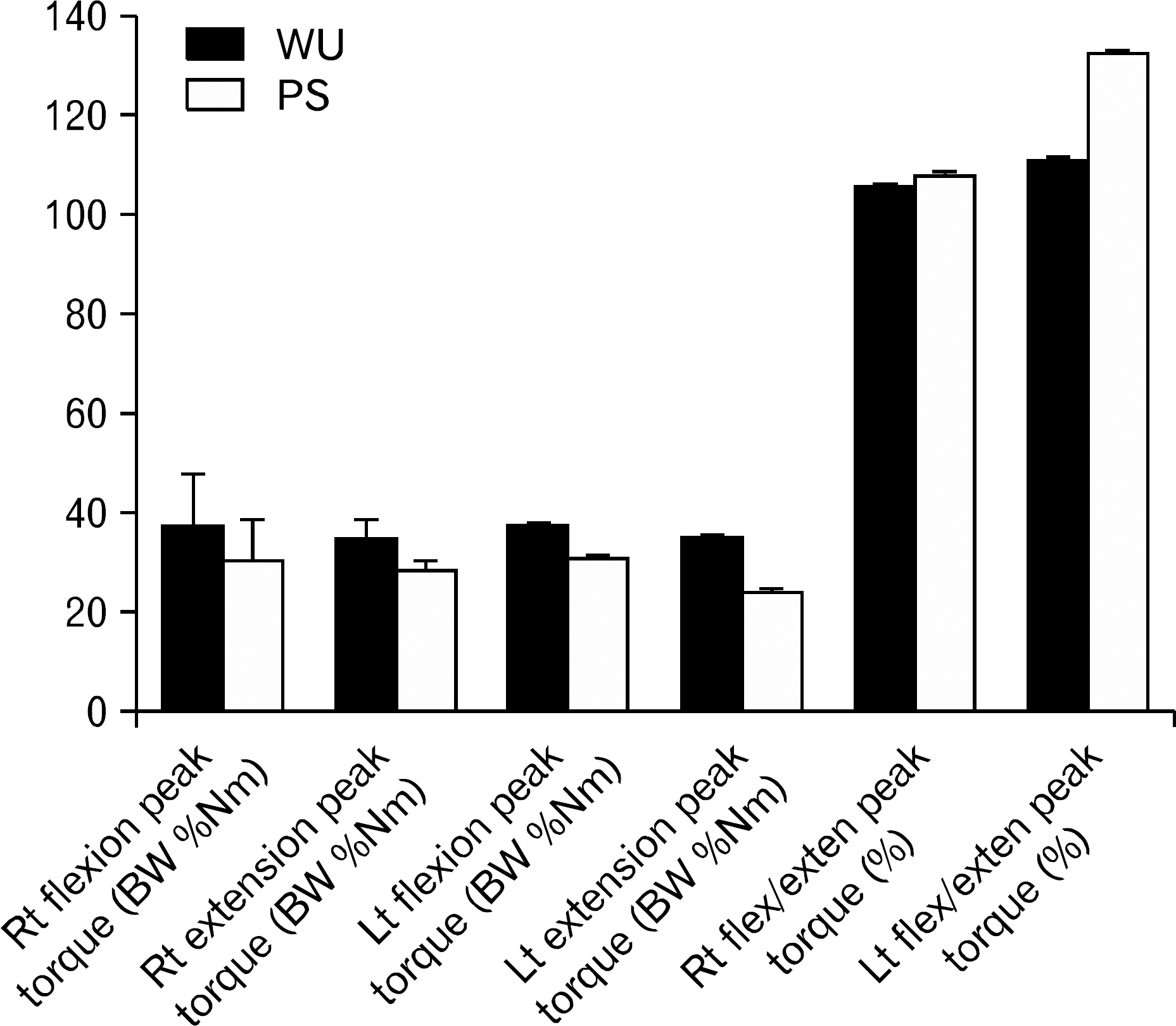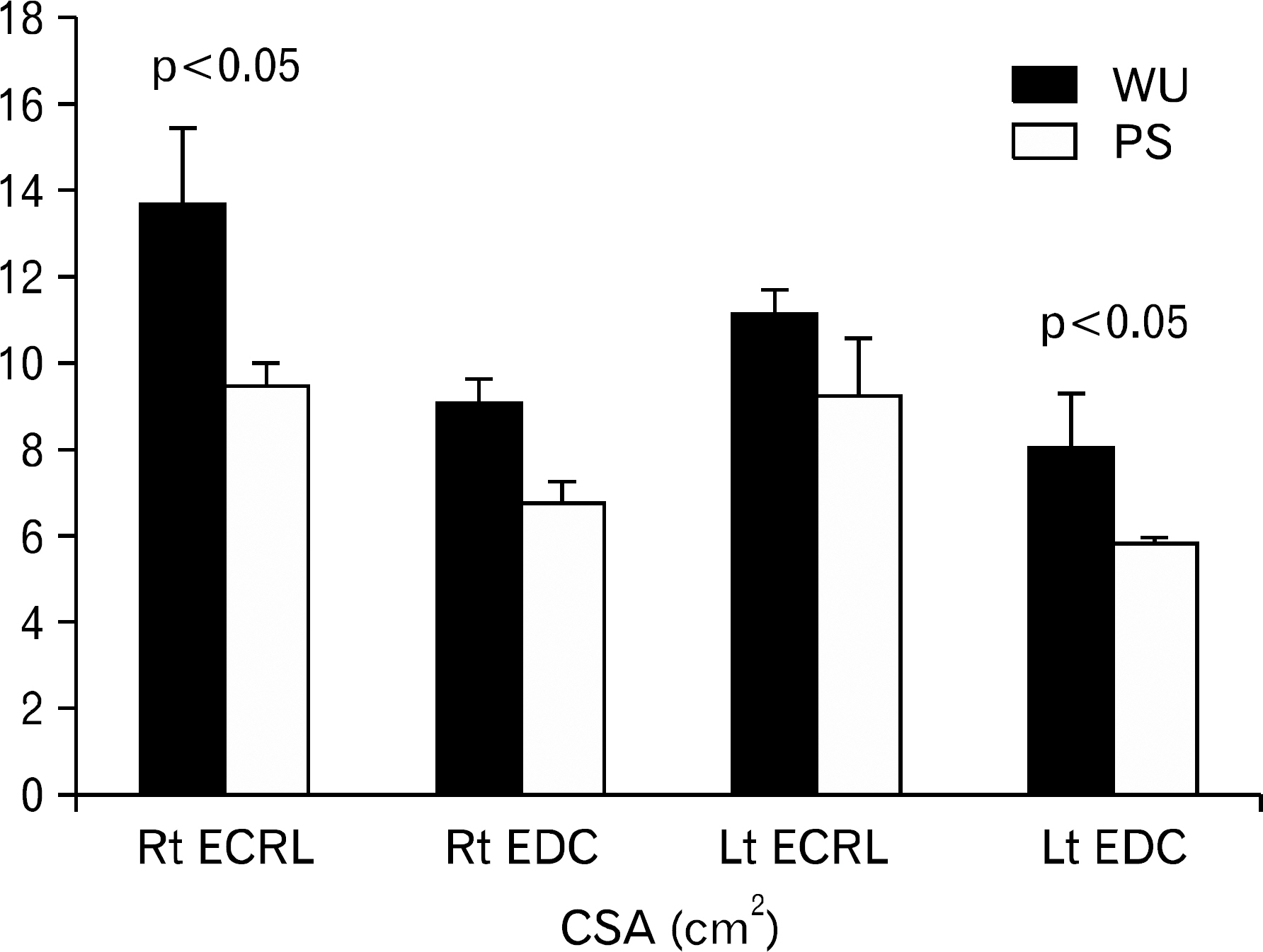Korean J Sports Med.
2018 Mar;36(1):24-33. 10.5763/kjsm.2018.36.1.24.
The Influence of Wheelchair Use of Individuals with Spinal Cord Injury on Upper Extremity Muscular Function and Cross-Sectional Area
- Affiliations
-
- 1Department of Prescription and Rehabilitation of Exercise, Dankook University, Cheonan, Korea. shinagel@dankook.ac.kr
- 2Korea Paralympic Committee, Seoul, Korea.
- KMID: 2465226
- DOI: http://doi.org/10.5763/kjsm.2018.36.1.24
Abstract
- PURPOSE
This study was to compare the upper extremity muscular function and cross-sectional area (CSA) between wheelchair users and a pedestrian group and to observe how the changes in the muscle CSA affected upper extremity muscle function.
METHODS
The study was conducted on 10 patients with spinal cord injury (SCI) who were divided into two groups based on whether they used wheelchairs (wheelchair using [WU] group and pedestrian [PS] group). The Mann-Whitney U-test was used to analyze the data and determine whether there were significant differences between the groups.
RESULTS
Muscle mass in the WU group was significantly lower than in the PS groups (p < 0.01), while body fat percentage in the WU group was significantly higher than in the PS group (p < 0.05). The peak torque of shoulder external and right internal rotation was higher in the WU group than in the PS group (p < 0.05). Wrist muscle function was not significantly different for either group. In addition, the CSA of the right wrist extensor carpi radialis longus and left extensor digitorum communis was higher in the WU group than in the PS group (p < 0.05).
CONCLUSION
Using a manual wheelchair may benefit upper extremity function by increasing CSA and muscle function in patients with SCI despite having a negative effect on body composition. However, there is an increased risk of injury with SCI associated with upper extremity overload; thus, an effective exercise protocol is needed to prevent muscle imbalance and injury.
MeSH Terms
Figure
Reference
-
References
1. Ministry of Health and Welfare. 2014 Real condition of the disabled person. Sejong: Ministry of Health and Welfare;2015.2. Weld KJ, Graney MJ, Dmochowski RR. Differences in bladder compliance with time and associations of bladder management with compliance in spinal cord injured patients. J Urol. 2000; 163:1228–33.
Article3. Sinnott KA, Milburn P, McNaughton H. Factors associated with thoracic spinal cord injury, lesion level and rotator cuff disorders. Spinal Cord. 2000; 38:748–53.
Article4. Finley MA, Rasch EK, Keyser RE, Rodgers MM. The biomechanics of wheelchair propulsion in individuals with and without upper-limb impairment. J Rehabil Res Dev. 2004; 41:385–95.
Article5. Curtis KA, Tyner TM, Zachary L, et al. Effect of a standard exercise protocol on shoulder pain in longterm wheelchair users. Spinal Cord. 1999; 37:421–9.
Article6. Kim CJ, Ku KM, Kim KS. The development of open-kinetic chain strength program for effective propulsion of manual wheelchair user. Korean J Exerc Rehabil. 2010; 6:231–40.7. Bayley JC, Cochran TP, Sledge CB. The weightbearing shoulder: the impingement syndrome in paraplegics. J Bone Joint Surg Am. 1987; 69:676–8.
Article8. Tyler TF, Nicholas SJ, Roy T, Gleim GW. Quantification of posterior capsule tightness and motion loss in patients with shoulder impingement. Am J Sports Med. 2000; 28:668–73.
Article9. Curtin CM, Gater DR, Chung KC. Upper extremity reconstruction in the tetraplegic population, a national epidemiologic study. J Hand Surg Am. 2005; 30:94–9.
Article10. Boninger ML, Impink BG, Cooper RA, Koontz AM. Relation between median and ulnar nerve function and wrist kinematics during wheelchair propulsion. Arch Phys Med Rehabil. 2004; 85:1141–5.
Article11. Mercer JL, Boninger M, Koontz A, Ren D, Dyson-Hudson T, Cooper R. Shoulder joint kinetics and pathology in manual wheelchair users. Clin Biomech (Bristol, Avon). 2006; 21:781–9.
Article12. Moon SJ, Kim TH, Roh JS. A comparison of the serratus anterior muscle activity according to the shoulder flexion angles in a closed kinetic chain exercise and an open kinetic chain exercise. J Korean Soc Phys Med. 2013; 8:369–78.
Article13. Ellenbecker TS, Davies GJ. Closed kinetic chain exercise: a comprehensive guide to multiple joint exercise. Champaign: Human Kinetics;2001.14. Gater DR Jr, Dolbow D, Tsui B, Gorgey AS. Functional electrical stimulation therapies after spinal cord injury. Neuro-Rehabilitation. 2011; 28:231–48.
Article15. Gorgey AS, Dolbow DR, Dolbow JD, Khalil RK, Castillo C, Gater DR. Effects of spinal cord injury on body composition and metabolic profile: part I. J Spinal Cord Med. 2014; 37:693–702.16. Kotajarvi BR, Basford JR, An KN. Upper-extremity torque production in men with paraplegia who use wheelchairs. Arch Phys Med Rehabil. 2002; 83:441–6.
Article17. Bernard PL, Codine P. Isokinetic shoulder of paraplegics: observation of global and specific muscle ratio. Int J Rehabil Res. 1997; 20:91–8.18. Suchomel TJ, Stone MH. The relationships between hip and knee extensor cross-sectional area, strength, power, and potentiation characteristics. Sports. 2017; 5:66.
Article19. Teyhen DS, Gill NW, Whittaker JL, Henry SM, Hides JA, Hodges P. Rehabilitative ultrasound imaging of the abdominal muscles. J Orthop Sports Phys Ther. 2007; 37:450–66.
Article20. Dudley-Javoroski S, McMullen T, Borgwardt MR, Peranich LM, Shields RK. Reliability and responsiveness of musculoskeletal ultrasound in subjects with and without spinal cord injury. Ultrasound Med Biol. 2010; 36:1594–607.
Article21. Gorgey AS, Timmons MK, Michener LA, Ericksen JJ, Gater DR. Intra-rater reliability of ultrasound imaging of wrist extensor muscles in patients with tetraplegia. PM R. 2014; 6:127–33.
Article22. Spungen AM, Adkins RH, Stewart CA, et al. Factors influencing body composition in persons with spinal cord injury: a cross-sectional study. J Appl Physiol (1985). 2003; 95:2398–407.
Article23. Kim SS, Hwang BG, Kim TS, Lee CI, Yang JS, Lee DH. The comparison of segmental body composition and bone mineral density in spinal cord-injured and non-injured control subjects. J Adapt Phys Activ Exerc. 2003; 11:29–43.24. Mulroy SJ, Farrokhi S, Newsam CJ, Perry J. Effects of spinal cord injury level on the activity of shoulder muscles during wheelchair propulsion: an electromyographic study. Arch Phys Med Rehabil. 2004; 85:925–34.
Article25. Kong JY, Jeong DH, Kwon HC. The effects of wheelchair propulsion speed changes on the shoulder impingement syndrome. Korean Soc Occup Ther. 2002; 10:69–83.26. Lee M, Shin H. A review of lateral epicondylitis. J Korean Acad Ortho Man Ther. 2005; 11:108–18.27. Ikai M, Fukunaga T. Calculation of muscle strength per unit cross-sectional area of human muscle by means of ultrasonic measurement. Int Z Angew Physiol. 1968; 26:26–32.
Article28. Fukunaga T, Miyatani M, Tachi M, Kouzaki M, Kawakami Y, Kanehisa H. Muscle volume is a major determinant of joint torque in humans. Acta Physiol Scand. 2001; 172:249–55.
Article29. Higbie EJ, Cureton KJ, Warren GL 3rd, Prior BM. Effects of concentric and eccentric training on muscle strength, cross-sectional area, and neural activation. J Appl Physiol (1985). 1996; 81:2173–81.30. Kim TW, Park BY. The effect of biceps brachii activation on wrist joint factors about hyperextension of elbow joint. J Korea Soc Wellness. 2011; 6:121–8.
- Full Text Links
- Actions
-
Cited
- CITED
-
- Close
- Share
- Similar articles
-
- Corrigendum to “The Influence of Wheelchair Use of Individuals with Spinal Cord Injury on Upper Extremity Muscular Function and Cross-Sectional Areaâ€
- Risk Factors for Suicidality in Individuals With Spinal Cord Injury: A Focus on Physical and Functional Characteristics
- Attenuation of Self-biting in Spinal Cord Injury by Functional Upper Extremity Surgery and Gabapentin Administration: A case report
- Subacute Delayed Ascending Myelopathy after Spinal Cord Injury from Flexion-distraction Injury of Low Thoracic Spine: A Case Report
- Upper Extremity Peripheral Nerve Entrapments among Wheelchair Users

